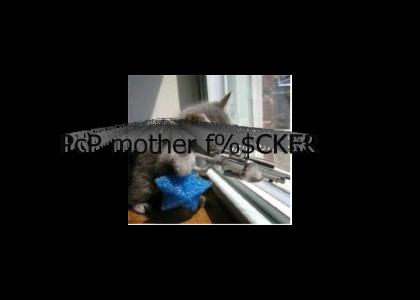My cat on PcP
Created on: October 24th, 2010

kittys
Sponsorships:
| user | amount | user | amount |
|---|---|---|---|
| No one has sponsored this site ( ._.) | |||
| Sponsor this site! | Total: $0.00 | Active: $0.00 | |
Vote metrics:
| rating | total votes | favorites | comments |
|---|---|---|---|
| (1.86) | 7 | 0 | 4 |
View metrics:
| today | yesterday | this week | this month | all time |
|---|---|---|---|---|
| 0 | 0 | 0 | 0 | 1,591 |
Inbound links:
| views | url |
|---|---|
| 48 | https://www.bing.com |
| 8 | http://www.google.com.hk |
| 4 | http://216.18.188.175:80 |
| 1 | https://www.google.com/ |
| 1 | http://www.google.com |
Phencyclidine
From Wikipedia, the free encyclopedia
Jump to: navigation, search
This article needs attention from an expert on the subject. See the talk page for details. WikiProject Pharmacology or the Pharmacology Portal may be able to help recruit an expert. (January 2010)
Phencyclidine
Systematic (IUPAC) name
1-(1-phenylcyclohexyl)piperidine
Identifiers
CAS number 77-10-1
ATC code None
PubChem CID 6468
DrugBank DB03575
ChemSpider 6224
Chemical data
Formula C17H25N
Mol. mass 243.387 g/mol
Pharmacokinetic data
Half-life 7-46 hours
Therapeutic considerations
Pregnancy cat. ?
Legal status Schedule I (CA) ? (UK) Schedule II (US)
Routes Smoked, Insufflated, Oral
YesY(what is this?) (verify)
Phencyclidine (a complex clip of the chemical name 1-(1-phenylcyclohexyl)piperidine, commonly initialized as PCP), also known as angel dust and other street names, is a recreational, dissociative drug formerly used as an anesthetic agent, exhibiting hallucinogenic and neurotoxic effects.[1] Developed in 1926,[2] it was first patented in 1952 by the Parke-Davis pharmaceutical company and marketed under the brand name Sernyl. In chemical structure, PCP is an arylcyclohexylamine derivative, and, in pharmacology, it is a member of the family of dissociative anesthetics. PCP works primarily as an NMDA receptor antagonist, which blocks the activity of the NMDA receptor and, like most antiglutamatergic hallucinogens, is significantly more dangerous than other categories of hallucinogens.[3][4] Other NMDA receptor antagonists include ketamine, tiletamine, and dextromethorphan. Although the primary psychoactive effects of the drug lasts for a few hours, the total elimination rate from the body typically extends eight days or longer.
Contents
[hide]
* 1 Biochemistry and pharmacology
o 1
From Wikipedia, the free encyclopedia
Jump to: navigation, search
This article needs attention from an expert on the subject. See the talk page for details. WikiProject Pharmacology or the Pharmacology Portal may be able to help recruit an expert. (January 2010)
Phencyclidine
Systematic (IUPAC) name
1-(1-phenylcyclohexyl)piperidine
Identifiers
CAS number 77-10-1
ATC code None
PubChem CID 6468
DrugBank DB03575
ChemSpider 6224
Chemical data
Formula C17H25N
Mol. mass 243.387 g/mol
Pharmacokinetic data
Half-life 7-46 hours
Therapeutic considerations
Pregnancy cat. ?
Legal status Schedule I (CA) ? (UK) Schedule II (US)
Routes Smoked, Insufflated, Oral
YesY(what is this?) (verify)
Phencyclidine (a complex clip of the chemical name 1-(1-phenylcyclohexyl)piperidine, commonly initialized as PCP), also known as angel dust and other street names, is a recreational, dissociative drug formerly used as an anesthetic agent, exhibiting hallucinogenic and neurotoxic effects.[1] Developed in 1926,[2] it was first patented in 1952 by the Parke-Davis pharmaceutical company and marketed under the brand name Sernyl. In chemical structure, PCP is an arylcyclohexylamine derivative, and, in pharmacology, it is a member of the family of dissociative anesthetics. PCP works primarily as an NMDA receptor antagonist, which blocks the activity of the NMDA receptor and, like most antiglutamatergic hallucinogens, is significantly more dangerous than other categories of hallucinogens.[3][4] Other NMDA receptor antagonists include ketamine, tiletamine, and dextromethorphan. Although the primary psychoactive effects of the drug lasts for a few hours, the total elimination rate from the body typically extends eight days or longer.
Contents
[hide]
* 1 Biochemistry and pharmacology
o 1
Bold
Italic
Underline
Code
User Link
Site Link